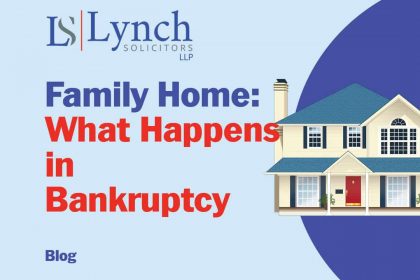
The position of the family home in Bankruptcy is that while the Lender has options under the legislation they invariably keep the family home out of bankruptcy.
This means that the lender proves their debt, the bankrupt’s interest vests in the official assignee, the lender retains control of the asset, and the assignee does nothing where the home remains in negative equity.
Negative Equity on the Family Home
Where the home continues to be in negative equity, the official assignee will allow the bankrupt’s interest to be released back after three years. In the meanwhile, the assignee in bankruptcy will do nothing and will not object to the lender selling the home [as mortgagee in possession]. Selling as mortgagee in possession means that the lender can do all the required legal formalities to sell the home. The assignee however takes no active part in the process of sale.
The matter can be complicated if the property is held jointly with a spouse or partner.
Furthermore, the matter will be complicated if there is equity during the three-year period in the property. In such circumstances, the assignee in bankruptcy is entitled to apply to the court for an order for sale.
Video: A Guide to Bankruptcy & the Family Home
John Lynch looks at the issues involved in bankruptcy and the family home in this video.
Lynch Solicitors for Information Purposes Only
Proven Debt
There have been situations where the lender has proven their debt but has not in fact gone on to sell the family home even though it’s in negative equity. In such circumstances, the bankrupt has two choices.
- He or she can vacate the family home which has the effect of writing off any residual debt over the value of the security. This is in effect a voluntary surrender.
- They can, with the consent of the bank, remain in the property on the basis of a revised are reviewable payment arrangement. If, however, they remain in the property they continue to be responsible for the entire date under the mortgage.
This raises the interesting scenario that if the discharge bankrupt subsequently vacates the family home whether the lender would be entitled to pursue the balance in circumstances where such a balance had been written off through the bankruptcy process.
Where the family home as a negative equity there have been a number of initiatives – the buy to let scheme – to try and keep people in their homes.
If someone is considering bankruptcy and is in discussions with their lender to put a buy to let the proposal in place, they should ensure that the lender is prepared to continue with the buy to let the proposal in the event of an application for bankruptcy.
Where the house is in negative equity, a buy to let the proposal gives the lender the value of the security. The lender/owner then transfers the house to the local authority or other agency who purchases the house from them. That agency in turn enters into a letting agreement with the debtor. If the debtor becomes bankrupt, the official assignee will not object to the lender selling to the local authority or other agency [as mortgagee in possession].
It is therefore critically important to investigate the likely outcome of bankruptcy where the family home is involved and where the bankrupt may wish to retain the family home.
Can We Help?
We assist individuals with issues relating to bankruptcy and personal insolvency. Contact us today on 052 61 24344 or email: reception@lynchsolicitors.ie

